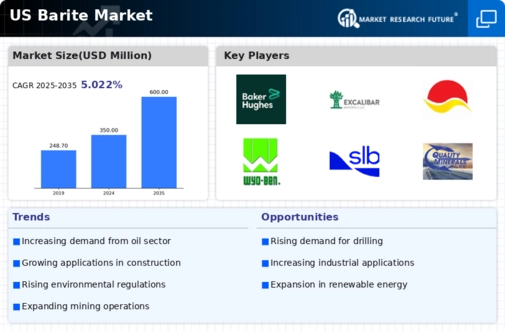The barite market exhibits a competitive landscape characterized by a blend of established players and emerging companies, driven by increasing demand in the oil and gas sector, as well as applications in construction and manufacturing. Key players such as Schlumberger (US), Halliburton (US), and Baker Hughes (US) dominate the market, leveraging their extensive operational capabilities and technological advancements. Schlumberger (US) focuses on innovation and digital transformation, enhancing its service offerings through advanced data analytics and automation. Halliburton (US) emphasizes strategic partnerships and regional expansion, particularly in North America, to bolster its market presence. Baker Hughes (US) is actively pursuing sustainability initiatives, aligning its operations with environmental standards, which appears to resonate well with current market expectations.
The business tactics employed by these companies include localizing manufacturing and optimizing supply chains to enhance efficiency and reduce costs. The market structure is moderately fragmented, with a few dominant players exerting considerable influence while allowing room for smaller companies to thrive. This dynamic fosters a competitive environment where innovation and operational excellence are paramount.
In October 2025, Schlumberger (US) announced a strategic partnership with a leading technology firm to develop AI-driven solutions for barite extraction and processing. This move is likely to enhance operational efficiency and reduce environmental impact, positioning Schlumberger (US) as a frontrunner in sustainable practices within the industry. Similarly, in September 2025, Halliburton (US) expanded its manufacturing capabilities in Texas, aiming to increase production capacity by 20%. This expansion is expected to meet the growing demand for barite in the region, thereby strengthening Halliburton's (US) competitive edge.
In August 2025, Baker Hughes (US) launched a new line of eco-friendly barite products, which are designed to minimize environmental impact during drilling operations. This initiative not only aligns with global sustainability trends but also caters to the increasing demand for environmentally responsible solutions in the oil and gas sector. The introduction of these products may enhance Baker Hughes' (US) market share and appeal to environmentally conscious clients.
As of November 2025, the competitive trends in the barite market are increasingly defined by digitalization, sustainability, and the integration of advanced technologies such as AI. Strategic alliances among key players are shaping the landscape, fostering innovation and enhancing operational capabilities. The shift from price-based competition to a focus on technological advancement and supply chain reliability is evident, suggesting that companies that prioritize innovation and sustainability will likely emerge as leaders in the evolving market.



















Leave a Comment